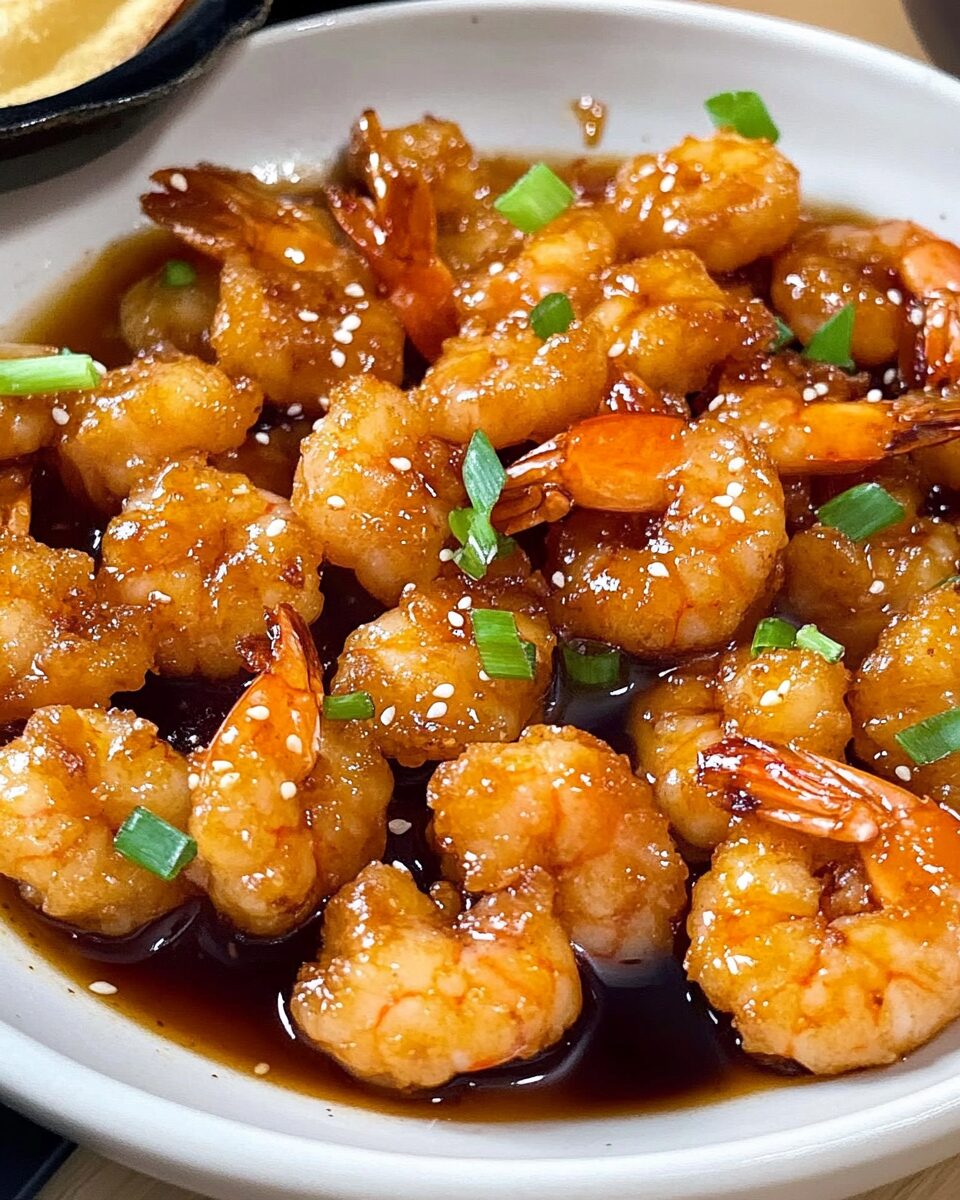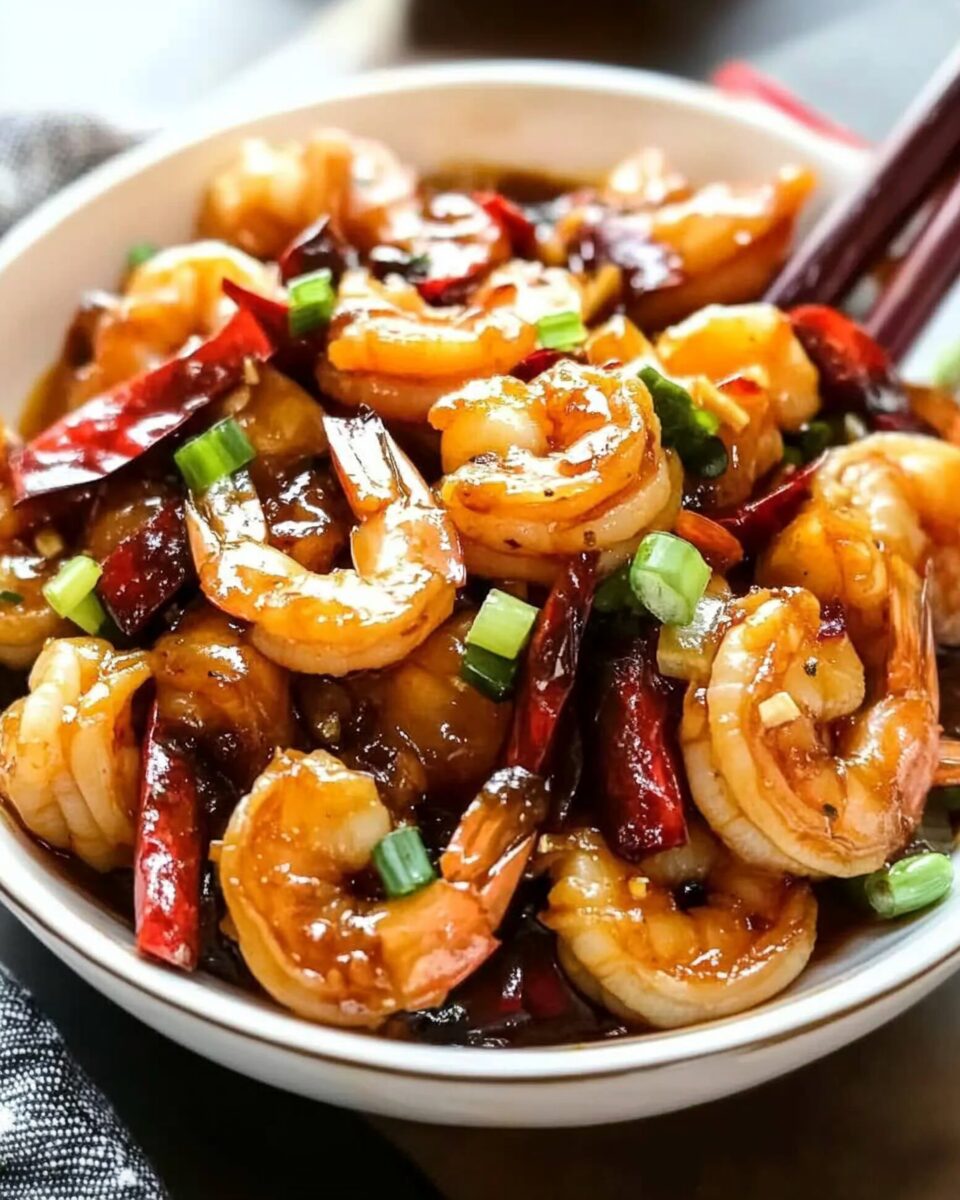Mongolian Shrimp is a delectable dish that combines succulent shrimp coated in a light, crispy batter, stir-fried with a sweet and savory Chinese-style sauce. This seafood adaptation of the classic Mongolian beef offers bold flavors and a satisfying crunch, making it a delightful choice for dinner. The dish is typically garnished with green onions and sesame seeds, adding freshness and a subtle nutty flavor. It’s a versatile recipe that can be served over steamed rice or alongside vegetables for a complete meal.
Full Recipe:
Ingredients
For the Shrimp:
- 1 pound large shrimp, peeled and deveined
- 1 egg white
- ½ cup tapioca starch or cornstarch
- ¼ cup avocado oil or coconut oil (for frying)
For the Mongolian Sauce:
- 2 tablespoons soy sauce (or tamari for gluten-free)
- 1 tablespoon hoisin sauce
- 2 tablespoons honey
- 2 cloves garlic, minced
- 1 teaspoon fresh ginger, grated
- ½ teaspoon chili flakes or Sriracha (optional, for spice)
- 2 tablespoons water
For Garnish:
- 2 green onions, sliced
- 1 teaspoon sesame seeds
Directions
-
Prepare the Shrimp: In a bowl, whisk the egg white until frothy. Add the shrimp and coat well. Dredge the shrimp in tapioca starch or cornstarch to lightly coat.
-
Fry the Shrimp: Heat oil in a large skillet over medium-high heat. Add shrimp in batches and fry for 1–2 minutes per side until golden and crispy. Remove and set aside.
-
Make the Sauce: In the same skillet, reduce heat to medium. Add garlic, ginger, soy sauce, hoisin sauce, honey, water, and chili flakes. Stir and simmer until the sauce thickens slightly.
-
Combine: Return the fried shrimp to the skillet and toss to coat evenly in the sauce. Cook for another minute to warm through.
-
Garnish and Serve: Remove from heat, garnish with sliced green onions and sesame seeds. Serve hot over rice or with vegetables.
Nutritional Facts
- Calories: 310 kcal
- Carbohydrates: 25g
- Protein: 26g
- Fat: 14g
- Saturated Fat: 2g
- Cholesterol: 185mg
- Sodium: 850mg
- Sugar: 10g
- Fiber: 1g
The History Behind Mongolian Flavors
Mongolian cuisine is known for its hearty and bold flavors, largely shaped by the country’s nomadic lifestyle. However, the dish “Mongolian Shrimp” as we know it today is not strictly from Mongolia. It is often considered a fusion dish, heavily influenced by American Chinese or Asian-inspired flavors. The essence of the Mongolian dishes lies in the use of soy sauce, garlic, ginger, and sweeteners, which are used to enhance the taste of meat or seafood. Mongolian Shrimp combines these elements, offering a modern twist on the rich and savory flavors that are central to the Mongolian culinary tradition.
The Key Ingredients and Their Role
The star of this dish is, of course, the shrimp. Shrimp brings a light yet satisfying protein that pairs well with the bold and savory sauce. The sauce itself is typically a combination of soy sauce, hoisin sauce, and sugar. Soy sauce adds saltiness and umami, while hoisin sauce gives the dish a slightly sweet and tangy flavor. The addition of garlic and ginger gives the dish a distinct aroma, while green onions and red pepper flakes provide extra crunch and heat, balancing the sweetness of the sauce.
The vegetables in this dish, usually green onions and bell peppers, add freshness and color, complementing the tender shrimp. While the sauce is the highlight of the dish, these ingredients help round out the overall flavor profile, giving the dish a satisfying combination of savory, sweet, and spicy.
Preparing Mongolian Shrimp
Preparing Mongolian Shrimp is straightforward and quick, which makes it ideal for a weeknight dinner or even a special occasion. The shrimp is first sautéed until it’s golden brown, which enhances its flavor and texture. Once the shrimp is cooked, the sauce is made in the same pan, absorbing any remaining flavors left from the shrimp. This method of cooking ensures that the dish has a deep, cohesive taste with all the ingredients working together.
The key to achieving a flavorful Mongolian Shrimp is making sure the sauce is balanced. The sauce should not be overly sweet or salty but rather a harmonious blend of flavors that enhance the shrimp. A few adjustments to the quantities of soy sauce, hoisin sauce, and sugar can be made depending on personal preference. Adding a dash of chili flakes or sriracha can add an extra kick if desired.
Why You Should Try Mongolian Shrimp
Mongolian Shrimp is a wonderful dish because it is incredibly versatile. It can be served over a bed of steamed rice, noodles, or even enjoyed on its own. The dish is light yet flavorful and can easily be tailored to suit different tastes. It also offers a healthier alternative to traditional deep-fried shrimp recipes, as the shrimp is lightly sautéed rather than battered and fried.
The sweetness of the sauce combined with the freshness of the shrimp makes for a dish that satisfies a variety of palates. Additionally, the meal is packed with protein and nutrients, making it a great option for a balanced dinner.
Customizing Your Mongolian Shrimp
One of the best things about Mongolian Shrimp is its flexibility. If you’re not a fan of shrimp, the dish can easily be adapted to include other proteins such as chicken, beef, or tofu. The sauce and vegetables remain the same, and the result will still be a delicious, satisfying meal. For a more vibrant dish, you can experiment by adding other vegetables like carrots, broccoli, or snow peas. These will provide a crunchy texture and enhance the dish with additional layers of flavor.
For a gluten-free version of Mongolian Shrimp, substitute the soy sauce with tamari or a gluten-free soy sauce alternative. You can also make this dish spicier by adding more chili flakes, fresh chilies, or even a drizzle of spicy sesame oil to give it an extra punch.
Health Benefits of Mongolian Shrimp
Shrimp is an excellent source of protein, low in fat, and packed with essential nutrients like omega-3 fatty acids, selenium, and vitamin B12. Including shrimp in your diet offers numerous health benefits, such as supporting brain health, improving metabolism, and promoting heart health.
The vegetables in this dish, such as green onions and bell peppers, provide important vitamins and antioxidants. Bell peppers are especially rich in vitamin C, which boosts immunity, while green onions offer beneficial compounds that support healthy digestion.
The dish is generally low in calories but high in flavor, making it a great option for those looking for a light yet satisfying meal that doesn’t compromise on taste.
Serving Suggestions
Mongolian Shrimp can be served in many ways, depending on your preference. It is commonly served over a bed of steamed white or brown rice, which soaks up the flavorful sauce. You can also pair it with noodles, such as lo mein or soba noodles, for a more filling meal. If you prefer a lighter option, consider serving it alongside a fresh green salad or roasted vegetables to balance the richness of the sauce.
For a more festive presentation, garnish the dish with additional sliced green onions, toasted sesame seeds, or even a squeeze of fresh lime. These small additions can elevate the dish and make it look as great as it tastes.
Conclusion
Mongolian Shrimp is a delightful dish that combines bold, sweet, and savory flavors in a simple yet satisfying way. Whether you’re preparing it for a quick weeknight dinner or a special meal, it is sure to impress anyone who enjoys Asian-inspired cuisine. With its versatility, health benefits, and incredible taste, Mongolian Shrimp is a recipe you’ll want to make again and again.








